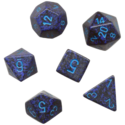| Part of a series on |
| Role-playing games |
|---|
 |
| Types |
| Movements & Traditions |
| Parts of Games |
| Participants |
| Lists |
|
|
The history of role-playing games began when disparate traditions of historical reenactment, improvisational theatre, and parlour games combined with the rulesets of fantasy wargames in the 1970s to give rise to tabletop role-playing games (TTRPGs).[1] Multiple TTRPGs were produced between the 1970s and early 1990s. In the 1990s, TTRPGs faced a decline in popularity. Indie role-playing game design communities arose on the internet in the early 2000s and introduced new ideas. In the late 2010s and early 2020s, TTRPGs experienced renewed popularity due to videoconferencing,[2][3] the rise of actual play,[4][5] and online marketplaces.
- ^ "Where we've been and where we're going". Archived from the original on 2011-06-29.: "Generation 1" games
- ^ Allison, Peter Ray (2021-04-21). "Tabletop roleplaying has given players comfort, connection and control in a world that's taken them away". Dicebreaker. Retrieved 2024-09-28.
- ^ "How COVID helped tabletop RPGs go mainstream". www.gameshub.com. 2021-10-26. Retrieved 2024-09-28.
- ^ DeVille, Chris (2017-11-16). "The rise of D&D liveplay is changing how fans approach roleplaying". The Verge. Retrieved 2024-09-29.
- ^ Whitten, Sarah (2020-03-14). "How Critical Role helped spark a Dungeons & Dragons renaissance". CNBC. Retrieved 2024-09-29.